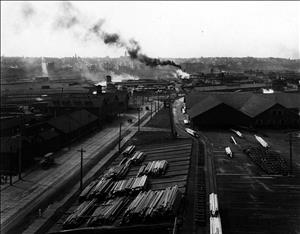On June 4, 1888, the St. Paul & Tacoma Lumber Co. incorporates. The incorporators are lumber and real-estate magnates who arrive that day by train from Minnesota and Wisconsin. The next day Tacoma headlines shout the event: "The monster milling company of Tacoma organized." The firm, known locally as the St. Paul, spurs what the historian Murray Morgan calls the greatest boom in Tacoma's history.
The St. Paul was capitalized at $1,500,000. The officers were:
- Colonel Chauncey Griggs, President. Colonel Griggs had made a fortune in real estate in St. Paul.
- Addison Foster, Vice President. Foster was the business partner of Griggs.
- Henry Hewitt Jr., Treasurer. A lumberman said to be the richest man in Wisconsin.
- George Browne, Secretary. Browne was vice president of the Tacoma and Fern Hill Street Railway Co.
- Charles Hebard Jones, in charge of all lumber and mining operations. He was Hewitt's partner and brother in law. He owned a lumber company in Menominee, Michigan.
- Peter J. Salscheider, millwright. Salscheider was supposed to be the best millwright in Wisconsin.
- Herbert Griggs, lawyer. Herbert was Chauncey Griggs's son, and a recent graduate of Yale. He would open a private law firm that would handle the legal business of the lumber company.
Before the firm was incorporated, these entrepreneurs had purchased 80,000 acres of Pierce County timberland, mostly Douglas fir, from the Northern Pacific Railroad's land grant. They had received from the Railroad a small island on the Tacoma waterfront called "the boot," and had purchased other land as well.
By 1889, they had built the mill, laid tracks into the forest, established camps and skidroads, and were transporting 50 carloads of logs a day into Tacoma for processing.

